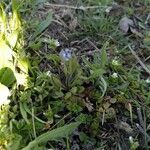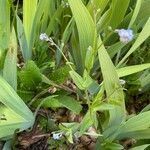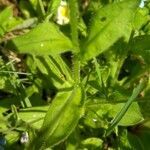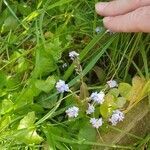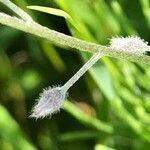Biennial or sometimes annual, 1–4 dm, often branched above, strigose to hirsute-puberulent throughout; lvs 1–6 cm × 3–16 mm, the lower mostly oblanceolate, the upper often more oblong or lanceolate; infl slightly if at all longer than the leafy part of the plant; mature pedicels ascending or spreading, equaling or generally surpassing the 3–5 mm cal; cal hirsute-puberulent and shortly uncinate-hispid; cor blue or occasionally white, the limb 2–4 mm wide; nutlets distinctly surpassing the style; 2n=50–54. Native of Eurasia, established in fields and roadsides from Nf. to Minn., s. sometimes to N.H. and W.Va. Summer.
Biennial. Stem up to 60 cm, robust, often much-branched at the base. Basal leaves up to 8 x 1.5 cm, oblanceolate, not distinctly petiolate. Leafy part of stem with patent hairs, the leafless part with appressed, straight hairs. Inflorescence ebracteate; pedicels directed upwards in fruit, the lowest up to 1 cm, becoming shorter above. Calyx up to 7 mm in fruit, closed, with many patent, hooked hairs especially at its base, deciduous. Limb of corolla c. 3 mm in diameter, saucer-shaped, bright blue. Nutlets up to 2.5 x 1.2 mm, greenish-black to black, pointed, with a rim; attachment-area small.
Annual or biennial herb, 0.15-0.20 m high. Stems patently hairy. Leaves sessile; blade narrowly obovate. Flowers in scorpioid cymes. Calyx 3-nerved, hairs spreading, some crisped or hooked. Corolla ± 1.5 mm long; tube white; lobes white, blue or purplish blue, fornices yellow. Flowering time Aug.-Dec. Fruit with stalk spreading, up to twice as long as calyx.
A herb. It grows 10-40 cm tall. It can grow each year from seed or grow for 2 years. The leaves are at the base. The leaf stalk has wide wings. The leaves on the stalk are alternate and without stalks. It is like Myosotis sylvatica but with smaller flowers. The flowers are small and blue. They are 3-4 mm across.
Softly hairy annual to 25 cm. Leaves lanceolate, to 30 x 4 mm. Flowers in helicoid cymes elongating in fruit, blue fading white, calyx closed in fruit. Nutlets ovoid, smooth, shining black.
